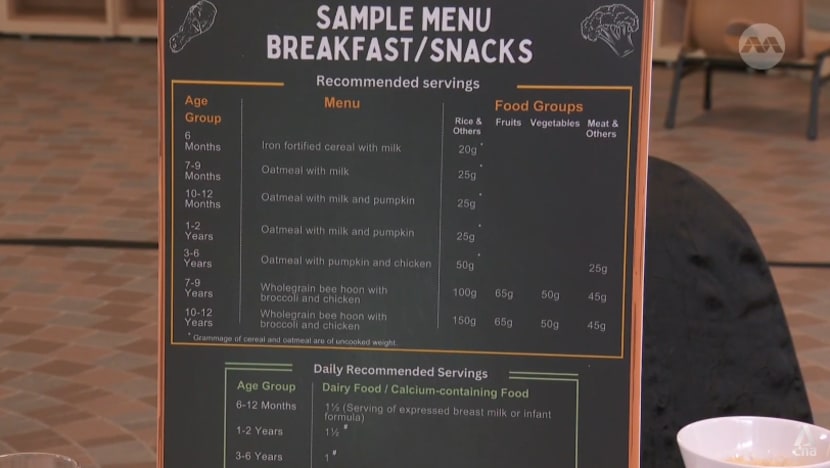New nutrition guidelines for children aim to help schools prepare healthy meals in appropriate portions
The initiative is part of the nation’s push to promote healthy eating habits by ensuring Singapore's children get a head start on eating better and safer.

School children in a canteen.
SINGAPORE: Children may soon be consuming more nutritious meals in schools here, after a new set of guidelines was released to promote healthy living from a younger age.
The Singapore Standard 692 Guidelines for Nutrition and Food Services for Infants and Children (SS 692) was launched on Wednesday (May 31).
Spearheaded by the National Healthcare Group (NHG), it will help care centres, school canteen operators and their food service providers prepare safe and nutritious meals for infants and children under 12 years old.
The guidelines provide recommendations across a wide range of areas, including portion sizes, nutritional balance, allergies management, and safety and hygiene practices.
The initiative aims to instil healthier eating habits and prevent both under- and overeating, from a young age.
NHG said it plans to reach out to more than 180 primary schools, 1,900 preschools and 400 student care centres to adopt the new standard.
RESOURCES AVAILABLE
The new recommendations come on top of existing Health Promotion Board (HPB) requirements.
“This standard complements the existing guidelines and provides age-appropriate portion and proportion, as well as resources to aid the implementation on the ground,” said Ms Wong Suat Li, NHG’s deputy director of group integrated care.
These include templates, checklists, pictorial guides and menu plans, she said.
For instance, a sample menu for breakfast suggests oatmeal with milk and pumpkin for children between 10 months to two years old.
For primary school students, it proposes wholegrain bee hoon with broccoli and chicken, a side of fruits, and a glass of milk. Upper primary students are recommended bigger portions compared to their younger schoolmates.

The new standard also covers a list of food that children may be allergic or sensitive to.
Additionally, it takes into account whether a child's dietary restrictions are clearly communicated.
GOOD EATING HABITS
One of the key issues the initiative hopes to address is overeating, on the back of a rise in childhood obesity.
Latest statistics from 2021 showed that 16 per cent of mainstream school students are overweight, an increase from 13 per cent in 2017.
“Good eating behaviour can mitigate a child’s risk of obesity, even for children with risk factors like having a father or mother who is overweight,” said Social and Family Development Minister Masagos Zulkifli.
“Conversely, studies show that poor eating habits and improper nutrition during childhood can lead to obesity, which in turn increases the risk of chronic diseases like diabetes, cardiovascular disease and certain cancers.”

Mr Masagos, who is also the Second Minister for Health, added that the early years are critical in developing the foundation for healthy eating and nutritional habits.
He urged parents to lead their children in healthy and active living, and make use of HPB’s educational programmes and resources on Parent Hub.
CHILDCARE OPERATORS ONBOARD
For canteen operators and caterers, guidelines include recommendations for the conduct of food safety and hygiene audits, such as kitchen cleanliness and how ingredients are prepared and labelled.
These standards can help guide food providers on what to look out for to prepare food that is safe for the young, and prevent adverse events such as food poisoning.
My First Skool, one of Singapore's largest childcare operators, is already looking at the new standard as a value-added resource to help ensure higher quality meals.
The preschool operator mostly prepares its food on site, in line with criteria under the HPB’s healthy meals programme, which calls for the usage of healthier ingredients such as lower sodium sauces, healthier oils, and brown rice.
Serving some 24,000 children each year, the firm said it hopes the new guidelines can further enhance both its in-house and outsourced meals.
“With the new standard, because of stronger understanding and the alignment of expectations, we will be able to find food providers who will be readily able to provide food with the quality that we need,” said the preschool chain’s general manager Thian Ai Ling.
BOOSTING INDUSTRY STANDARDS
Some firms in the catering industry are already gearing up to adopt these guidelines.
The Singapore Manufacturing Federation, which oversees 150 food and beverage providers, said it is actively encouraging members to do so and help boost industry standards.
“For infants and children, food safety is of paramount importance given their vulnerability in this age group,” said the federation’s council member Audrey Yap.
“The standard addresses this by looking at food and beverage (F&B) players who want to get involved with serving these particular needs, and to ensure that (food produced) is age-appropriate.”
Ms Yap said she is confident that caterers will be quick to adopt the guidelines as that would give them an edge in their business.
“With this awareness of (children’s) nutritional needs … consumers could be more selective, more targeted, more specific in what they want to eat, and also looking for a healthier lifestyle,” said Ms Yap.
“Accordingly, F&B businesses that step up to the plate and are able to address this sector very quickly, effectively and efficiently, will see a return on investment.”




















